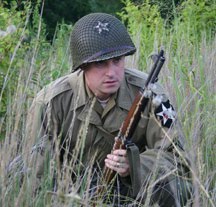For years I have referred to June 5th as the "night of nights." This time it marks the 67th anniversary of the Allied invasion of western Europe. And living in the "post-Band-of-Brothers-world" that we live in, it is known by many that it was the American 101st Airborne Division (and Easy Company of the 506th) that jumped from the darkened skies that night, battled it out with the treacherous nazi occupiers, and eventually won the day for the Allies. But the Screaming Eagles of the 101st were not alone on that fateful night. They were joined by their "big brothers" from the U.S. 82nd Airborne Division and the British 6th Airborne Division. And so this year, I felt that it was important to recognize those other paratroopers and glider-borne troops who fought so valiantly and captured and secured for the Allied forces their objectives on that night.
Of particular interest to me personally are the British paras known as the "Ox and Bucks" who captured Pagasus Bridge over the Orne River. A force of 181 men, led by Major John Howard, they took off from southern England in six Horsa Gliders to capture Pegasus Bridge, and also Horsa Bridge, a few hundred yards to the east. The force included elements of B and D Companies, 2nd Battalion, Oxfordshire and Buckinghamshire Light Infantry, a platoon of B Company, Royal Engineers, and men of the Glider Pilot Regiment. The object of this action was to prevent German armor from crossing the bridges and attacking the eastern flank of the landings at Sword Beach. Five of the Ox and Bucks' gliders landed as close as 47 yards from their objectives at 16 minutes past midnight. The attackers scrambled out of their crashed gliders, completely surprising the German defenders, and took the bridges within 10 minutes. They lost two men in the process. Lance Corporal Fred Greenhalgh drowned when his glider landed. And Lieutenant Den Brotheridge was killed crossing the bridge in the first minutes of the assault and thus became the first member of the Allied invasion forces to be killed in combat on D-Day. The Ox & Bucks were reinforced half-an-hour after the landings by the British 7th Parachute Battalion, and linked up with the beach landing forces upon the arrival of Lord Lovat's Commandos on June 6th. This photo shows the wreckage of one of the Horsa gliders and British forces marching over Pegasus Bridge.

Here is a photo of Lieutenant Herbert Denham "Den" Brotheridge. He commanded a platoon in Major Howard's 'D' Company of the Ox and Bucks and led a charge across Pegasus Bridge. He reached the opposite side of the bridge where he dropped a grenade into a machine-gun post. In the same instant he was shot through the neck. Mortally wounded, it was several hours before he died, but he was classed the first soldier to die as a result of enemy action on D-Day.

Lt. Den Brotheridge is buried in the War Cemetery in Ranville Churchyard near Caen, France. Ranville was the first village in France to be liberated. At the bottom of his marker it reads, "Out of the bitterness of war he found the perfect peace". Major Howard was informed of Lieutenant Brotheridge's injuries. He later wrote, "It really shook me, because it was Den and how much of a friend he was, and because my leading platoon was now without an officer. At the top of my mind was the fact that I knew Margaret, his wife, was expecting a baby almost any time." Denis Edwards, No.25 Platoon's sniper, wrote "every one of us was really distressed that Lieutenant Brotheridge should have been killed in that way at the very start of our mission. He was a man for whom we had the greatest respect. Like all our Airborne officers, he had never asked us to do anything that he would not do himself."































